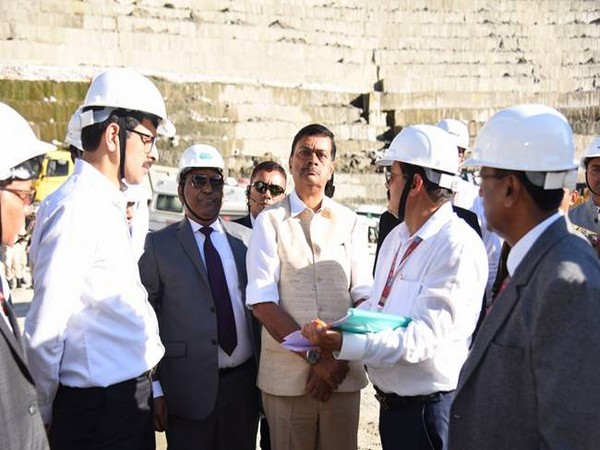Guwahati (Assam) [India], November 28 (ANI): Union Minister for Power and New and Renewable Energy RK Singh on Monday embarked on a visit to the 2000 MW Subansiri Lower Hydroelectric Project situated on the border of Arunachal Pradesh and Assam.
During his visit on Monday, the Minister revealed a plan involving 13 hydel projects in Arunachal Pradesh, aiming to attract a colossal investment of Rs 1.4 lakh crore.
This initiative not only promises to significantly increase the per capita income of the state but also vows to contribute 13,000 MW of clean power to the nation.
Singh emphasized the increasing hydropower capacity of India, highlighting the Memoranda of Understanding (MoUs) between the Government of Arunachal Pradesh and central public sector undertakings for 13 hydroelectric projects.
Singh said, “India’s hydropower capacity is increasing and besides Subansiri which is a large project, the Government of Arunachal Pradesh has entered into MoUs with central public sector undertakings for 13 projects, which will amount to a hydroelectric capacity of 13,000 MW in Arunachal”.
These projects, combined with the Subansiri endeavour, constitute a substantial leap towards harnessing a total hydroelectric capacity of 13,000 MW in the region.
“These projects will bring in investment of around Rs 1.4 lakh crore in the state, resulting in quadrupling of per capita income. And the nation will get clean power. Similarly, five hydel projects are under construction in Jammu & Kashmir; hence, our hydro potential in J&K too is moving ahead and a lot of investment is coming in,” remarked the Union Power Minister.
The Minister’s visit included a comprehensive inspection of the Subansiri project construction sites, encompassing the dam, intake structures, and diversion tunnels in Gerukamukh, Assam.
Following the inspection, Singh conducted a thorough review meeting, where he took stock of the ongoing construction activities and received briefings on the project’s progress.
He urged National Hydroelectric Power Corporation (NHPC) officials and contractors to work with maximum zeal, ensuring the completion of the project as per the designated schedule.
Expressing satisfaction with the project’s review, Singh addressed the media, underscoring the growing importance of hydel projects in India’s energy transition.
“I went into all the details and I believe that by and large, the project is progressing as it should. The importance of hydro projects has increased since we need to make energy transition, reduce emissions and move to renewables. While we have solar and wind too among renewables, round-the-clock renewable energy is not possible without hydro. Our hydro capacity is increasing,” the Minister said.
The Minister outlined the concerted efforts to tap into the country’s hydropower potential, citing the current hydropower capacity of 47,000 MW, constituting 35 per cent of the available hydropower potential. In contrast, developed countries have utilized 70 per cent to 80 per cent of their hydro potential.
“Today, our hydropower capacity is 47,000 MW, which is 35 per cent of our available hydropower potential. Developed countries however have utilized around 70 per cent – 80 per cent of their available hydro potential,” the Minister said.
Addressing the escalating power demand in India, Singh revealed a 20 per cent growth in demand from August to October 2023 compared to the previous year.
Singh said, “Our power demand grew by 20 per cent in August, September and October 2023, relative to the previous year. Our demand will keep growing at this rate, since according to NITI Aayog, our economy will keep growing at 7.5 per cent for the next two decades. The peak demand in 2013 was around 1.35 lakh MW, while today it is around 2.31 lakh MW”.
“Our power demand will become double by 2030; our total consumption today is 1,600 billion units, which will become around 3,000 billion units. However, even now, our power consumption is low compared to developed countries; Europe’s per capita power consumption is around 3 times that of ours today. Our challenge hence is to add power capacity as fast as the growth in our power demand,” Minister added.
He projected a continued growth rate due to the NITI Aayog’s estimation of India’s economy growing at 7.5 per cent for the next two decades.
Singh emphasized the necessity to add power capacity swiftly to meet the surging power demand, which is expected to double by 2030.
The Minister highlighted India’s transition from a power deficit nation to a surplus one, with the addition of 1.9 lakh MW power capacity in the last nine and a half years.
He disclosed ongoing and upcoming capacities in renewables and thermal power, aiming to meet the power demand of 2030.
“Earlier, we were a power deficit nation, but the government has added a power capacity of 1.9 lakh MW in the last nine and a half years. Now, we have sufficient power and we are also exporting to neighbouring countries such as Bangladesh and Nepal. Our under-construction capacity in renewables is around 70,000 MW, while in thermal, it is 27,000 MW. However, we are going to add another 53,000 MW to under-construction thermal capacity so that we are able to meet the power demand of 2030,” the Union Minister said.
Singh concluded by affirming India’s commitment to providing power to states in need and positioned India as a global leader in responsible energy growth. He referenced India’s accomplishment in COP21, achieving the 40 per cent non-fossil-fuel capacity target for 2030 in 2021, nine years ahead of schedule.
Minister Singh said, “In COP21 in Paris, we had committed to make 40 per cent of our capacity from non-fossil-fuel sources by 2030; we achieved this target in 2021, nine years in advance. Hence, we are growing faster than developed countries. Developed countries have become developed by using fossil fuels. Hence, if we need to use fossil fuels for our growth, we will use it”.
Singh added, “Our per capita carbon emissions are one-third of the global average; while per capita greenhouse gas emissions of developed countries are three times that of the global average. 80 per cent of the carbon dioxide load in the atmosphere due to which there has been a rise in global temperature is due to the emissions by developed countries, while our contribution to the cumulative load is just 3 per cent and our population is 17 per cent of world population”.
He stressed responsible growth, noting India’s per capita carbon emissions being one-third of the global average, contrasting with developed countries contributing 80 per cent to cumulative carbon dioxide load.
Accompanying the Minister during his visit were Union Power Secretary Pankaj Agarwal; CMD, NHPC, R. K. Vishnoi; Joint Secretary (Hydro), Ministry of Power, Mohammad Afzal; Director (Projects), NHPC, Biswajit Basu; Director (Technical), NHPC, R K Chaudhary; and HOP, Subansiri Lower Project, Rajendra Prasad. (ANI)












